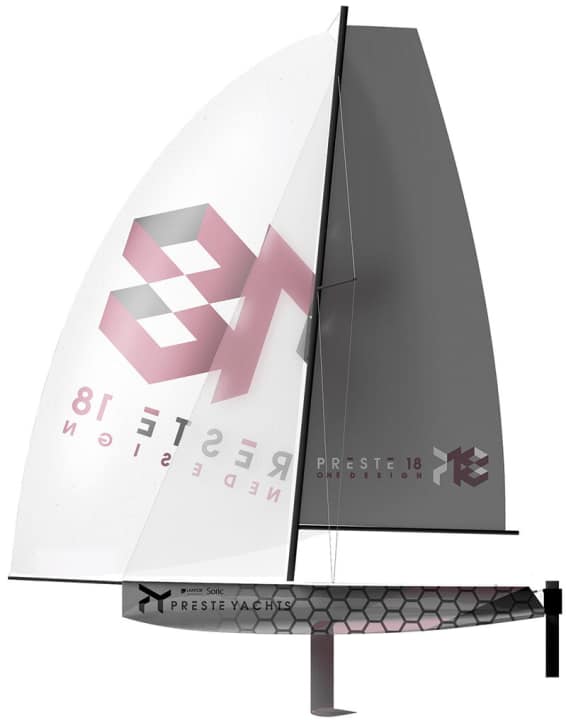





The prototype was completed in 2020, a few boats are already in circulation in Poland and there are now also two dealers in Germany. Preste Yachts wants to further popularise the sporty one-design keel dinghy and conquer the German-speaking market. The Preste 18 was on show in Germany for the first time at boot in Düsseldorf and attracted a lot of attention, and not just because of the magenta-coloured accents on the sails and hull.
This is because the shipyard wants to appeal to an exceptionally broad target group with its design. The Preste 18 should be able to win regattas as well as spend a relaxed and safe day sailing with children or beginners. The all-rounder should also be ready to sail in under an hour - including setting the mast. With a complete weight of around 338 kilograms and thanks to the lifting keel, it can not only be craned, but also slipped. The 5.50 metre long one-design dinghy is therefore also suitable for an after-work trip for all those who do not have a mooring available.
A 360° view of the Preste 18:
The Preste 18 is fast, but safe and uncomplicated
The fact that the draught can be reduced from 1.35 metres to just 35 centimetres has another advantage. This makes the Preste very suitable for sailing in inland waters. But it also wants to impress near the coast with plenty of wind and waves. In addition to its sailing characteristics, it also offers a high level of safety. The boat should be able to right itself in any conditions and never capsize. According to the shipyard, this is an important factor, especially for beginners, children and older sailing enthusiasts. The sporty Polin is ideal for a two-person crew, but can also be sailed with twice as many sailors or completely alone.
To make it easier for beginners and to focus on the sailors during the regattas, no more trim instruments than absolutely necessary are installed on board. The general concept is almost reminiscent of the Laser (Ilca), which is by far the most minimalist boat in the Olympic programme with only three outriggers.
Keel dinghy with borrowings from the skiff sector
One small exception is the 29 square metre gennaker, but even here the simplest technique for the crew is used. To hoist the large asymmetrical headsail and deploy the gennaker pole, only one line needs to be pulled. The same applies to hoisting up to the trumpet provided for this purpose. This system is widespread and is also used in the Olympic 49er class. The same applies to the self-tacking jib on a rail attached in front of the mast.
In general, some borrowings from the skiff sector can be seen, such as the rudder blade or the general hull shape with a very flat underwater hull and hard edges.
Modern production technology for more rigidity
Those who don't want to miss out on the sporty side have the option of sailing the keel dinghy with a trapeze. The Polish design then promises even more sailing fun and, of course, higher speeds - the 20-knot mark is said to have already been reached.
At this point, you will find external content that complements the article. You can display and hide it with a click.
A special feature of this all-rounder is the manufacturing technology used. The honeycomb foam core promises particularly high rigidity and durability with low mass. Further advantages of the honeycomb are the even thickness of the hull and low resin absorption.
Interested parties can still see the Preste 18 in Hall 15 at boot Düsseldorf until the end of the weekend. The shipyard is also aiming to increase the number of dealers in Germany from two to four.

Technical dataPreste 18
- Designer: Wojciech Kasprzak
- Hull length: 5.54 m
- Total length: 5.54 m
- Width: 2.16 m
- Draught: 0.35-1.35 m
- Weight: 338 kg
- Ballast: 78 kg
- Mast length: 8 m
- Mainsail: 12.5 m²
- Self-tacking jib: 7.5 m²
- Gennaker: 29 m²
- CE design category: C
- Price: from 24,999 euros incl. 19 % VAT

